Navigate Through a SharePoint Site
The following section explains the different mechanisms that help you
navigate through a site. A standard SharePoint site has two navigational
aids that help you find your way in the site. These navigation bars are
usually at the top and left sides of the screen. The site manager can
change them to show different links to different parts of the site, and
they should be your primary source of information to what you can view
in the site.
Figure 1 shows a sample site with both navigation bars configured to show the same information.
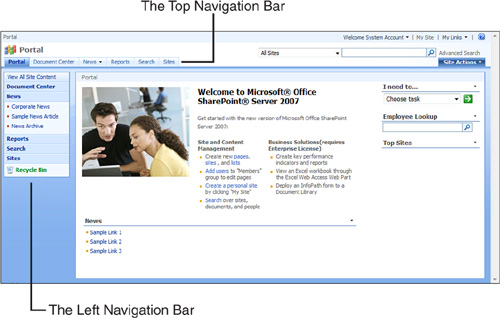
As you can see in the image,
both navigation bars show links to subsites that exist under the
current site and some of the actual content in one of those sites (the
News site has two news items in it: Sample News Article and News
Archive, which are pages in the News site). The top navigation bar
exposes those articles as flyouts that show only when you hover the
mouse cursor over the News menu item (see Figure 2).
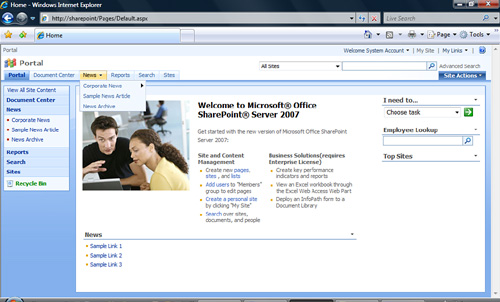
To navigate to a subsite,
you can click the links to that subsite in either navigation bar. Most
likely (depending on how your administrator set up the navigation), the
subsites show the same top navigation bar but a different left
navigation bar, as shown in Figure 3.
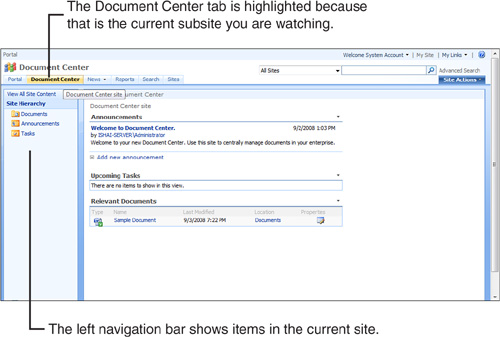
However,
the administrator can choose that a subsite will display the same left
navigation bar as the top site. This setup makes it look as if you are
still in the same site, except for the fact that the top navigation bar
highlights the current site you are on, as shown in Figure 4.

Use the Left Navigation Bar
The quick launch left navigation bar, also known as Current navigation,
is usually used to show content that exists in the current site and
sometimes content from subsites, sites that exist under the current site
(see Figure 5).
The content is usually (but not always) lists and libraries, and is
(usually) grouped so that document libraries are shown under a Documents
header, lists under a Lists header, discussions under a Discussions
header, and so on.
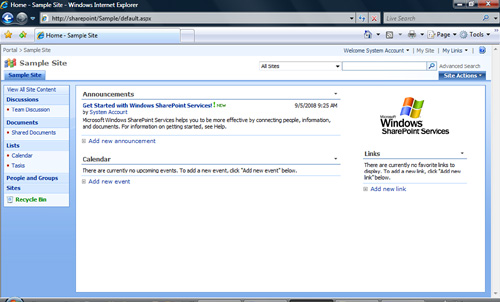
The left
navigation bar highlights where you are in the navigation, but only when
you are on a page that is shown in the navigation (see Figure 6).

This navigation bar is
meant to be used as a “quick launch” bar—a useful list of links in the
current site and sometimes the sites under it. It might even contain
links to content that isn’t in SharePoint—for example, an Internet site.
Tip
Some sites do not have a
left navigation bar. If that is the case, you must rely on the
information on the page to find your way in the site.
Use the Top Navigation Bar
The top navigation bar, also known as Global navigation,
is usually used to show links to sites that are at the top level of the
site hierarchy. This feature enables you to quickly see what important
sites are available globally that the site administrator wants you to
see.
This menu bar can support flyout
menus. These menus become visible when you hover the mouse cursor over
the parent menu items. You can usually know when a menu has flyout menus
as children: it is marked with a triangle pointing to the direction in
which the flyout menu will open.
In Figure 7,
you can see a two-level flyout menu. The first level shows that under
the News site, there is another site called Corporate News and also two
articles. The second level (on the right of the first level) shows that
there are three articles under the Corporate News site.

Tip
You can customize the top
navigation bar to show many levels of sites and sometimes other links.
If you see the small triangles or arrows, hover the mouse cursor over
them to find out what navigation item is under them.
Use the Breadcrumbs
Breadcrumbs
are a common mechanism to navigate in any website. They show you where
you are in the site and what parents this site has so that you can go up
the hierarchy to any of the parents easily and quickly.
In SharePoint, there are
two built-in breadcrumbs in each page: global and local. The global
breadcrumbs are usually at the top left of the screen and track where
you are when switching between sites that do not share the same
navigation bars (see Figure 8).
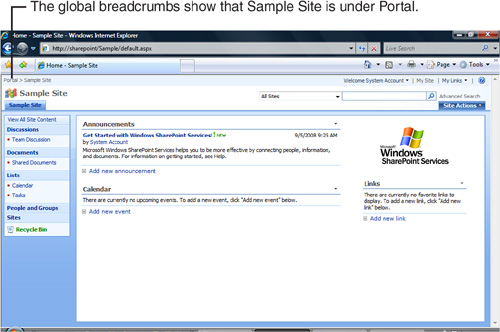
The local
breadcrumbs are usually right under the top navigation and show you
where you are in relation to the current site hierarchy (see Figure 9).
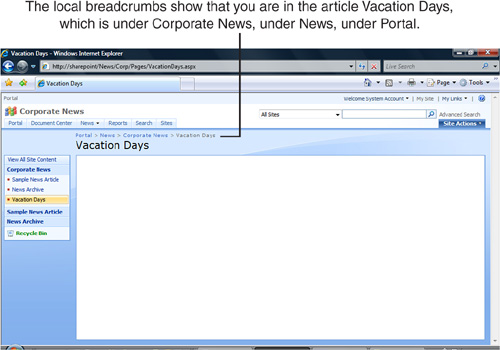
To use the breadcrumbs, just click the link of the parent you want to navigate to.
Tip
When you are in a
document library that has folders, using breadcrumbs is the best way to
go back to the parent folder of the one where you are currently working.